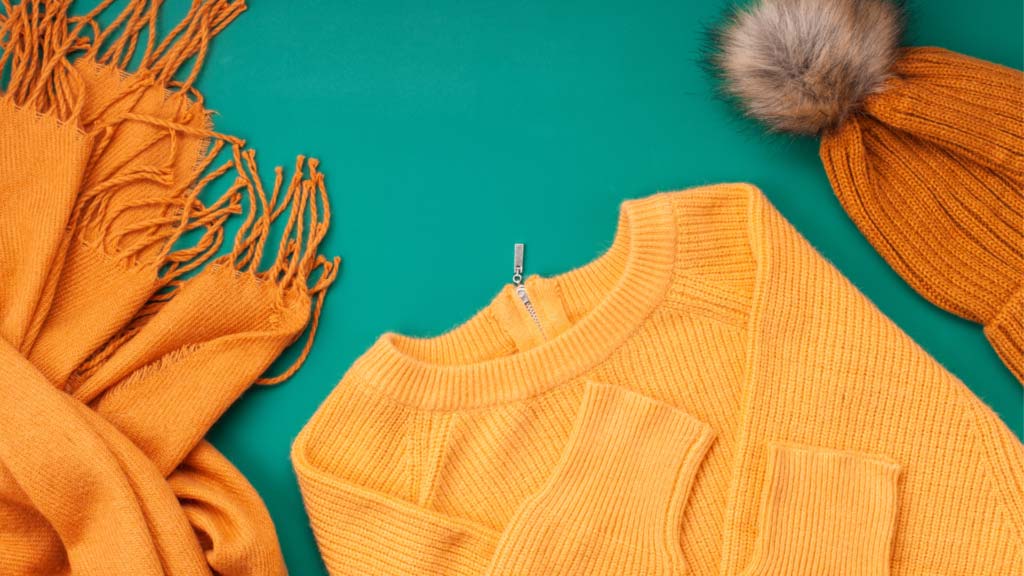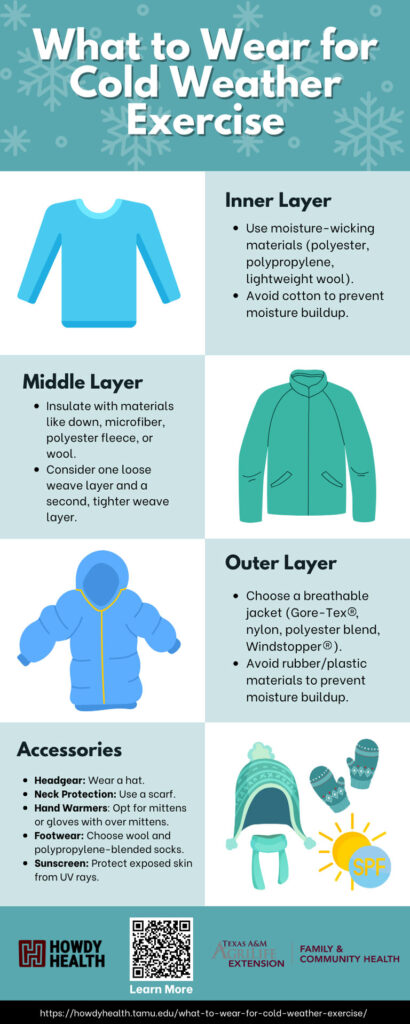Exercising in cold weather requires careful consideration of your clothing to stay both warm and dry—not only from the elements, but from your own sweat too.3,6 In addition to monitoring the temperature before exercising, it’s crucial to factor in windchill, which can make it feel colder than the thermometer reads.
Here are a few tips to guide you as you navigate exercising during the cold weather months. These tips focus on the importance of proper layering and the selection of appropriate materials for inner, middle, and outer layers to ensure comfort and safety in chilly conditions.
The Inner Layer
The layer closest to your skin should be comprised of moisture wicking materials that draw sweat away from your skin.4,7 These materials include:
- Polyester
- Polypropylene
- Lightweight wool2,3
This base layer is essential in preventing the cooling effect of sweat, particularly in colder temperatures. Avoid cotton, including your undergarments, because it absorbs moisture and can keep it next to your skin – making you cold.4,5
The Middle Layer
The middle layer is designed to insulate and trap warm air close to your body.1 Depending on the conditions and your activity level, you may need one or two middle layers. Choose between:
- Down
- Microfiber
- Polyester fleece
- Wool2,3,4
When using two middle layers, the first layer should be a loose weave (like a wool sweater) to allow for maximum air trapping.2 Tight-fitting clothes can keep your blood from freely flowing & can lead to loss of body heat. The second layer can be a tighter weave to reduce the effect of wind-chill and give you more insulation.4
The Outer Layer
This layer should serve as a lightweight and versatile shell jacket, providing protection from wind, rain, and snow.2,4,5 If the outer layer is not breathable, sweat can build up and be trapped inside, not allowing for proper evaporation.3 Look for clothing with breathable fabrics, such as:
- Gor-Tex®4
- Nylon
- Polyester Blend
- Windstopper®
Avoid rubber or plastic materials in the outer layer, which allow moisture to build up. Look for underarm zippers, venting pockets, and backflaps that allow for ventilation.
Accessories for Full Protection
Don’t overlook essential accessories to complete your cold-weather ensemble:
- Headgear: Wear a hat to cover your head and ears.2
- Neck Protection: Use a scarf to shield your neck.2,4
- Hand Warmers: Mittens are preferable for optimal warmth, or choose gloves with an over mitten for added protection.2,4
- Footwear: Opt for wool/polypropylene-blend socks that fit comfortably in your shoes without constricting your toes.4
- Sunscreen: Even in winter, protect exposed skin from harmful UV rays with sunscreen.
A strategic approach to cold weather clothing involves thoughtful layering and choosing materials that balance insulation with breathability. By following these guidelines and considering additional accessories, you can enjoy exercise and other outdoor activities in the winter while staying warm, dry, and protected.
Get moving in any climate with one of our walking programs like Walk Across Texas or the 10&10,000 Change Challenge.
Infographic
Download the PDF or share the image below to help others learn more about what to wear for cold weather exercise.
- National Institute on Aging. Safety tips for exercising outdoors for older adults. https://www.nia.nih.gov/health/safety-tips-exercising-outdoors-older-adults#cold. Published April 2, 2022. Accessed January 6, 2023.
- Centers for Disease Control and Prevention. Indoor safety | winter weather. https://www.cdc.gov/disasters/winter/duringstorm/indoorsafety.html. Published December 22, 2022. Accessed January 6, 2023.
- University Health Network. Dressing for Outdoor Exercise in Cold Weather | Cardiac College. https://www.healtheuniversity.ca/EN/CardiacCollege/Active/Exercise_And_Cold_Weather/Pages/dressing-for-outdoor-in-cold-weather.aspx. Accessed January 6, 2023.
- Bumgardner W. How you should properly dress to walk in Cold Weather. Verywell Fit. https://www.verywellfit.com/how-to-dress-for-cold-weather-walking-3435229. Published August 15, 2021. Accessed January 6, 2023.
- Vorvick LJ. Exercise clothing and shoes: Medlineplus Medical Encyclopedia. MedlinePlus. https://medlineplus.gov/ency/patientinstructions/000817.htm. Published August 13, 2020. Accessed January 6, 2023.
- Palca J. Summer science: Clothes keep you cool, more or less. NPR. https://www.npr.org/2012/07/25/157302810/summer-science-clothes-keep-you-cool-more-or-less. Published July 25, 2012. Accessed January 6, 2023.
- Nike.com. What is moisture wicking and how does it work? Nike.com. https://www.nike.com/a/what-is-moisture-wicking. Published July 27, 2022. Accessed January 6, 2023.





